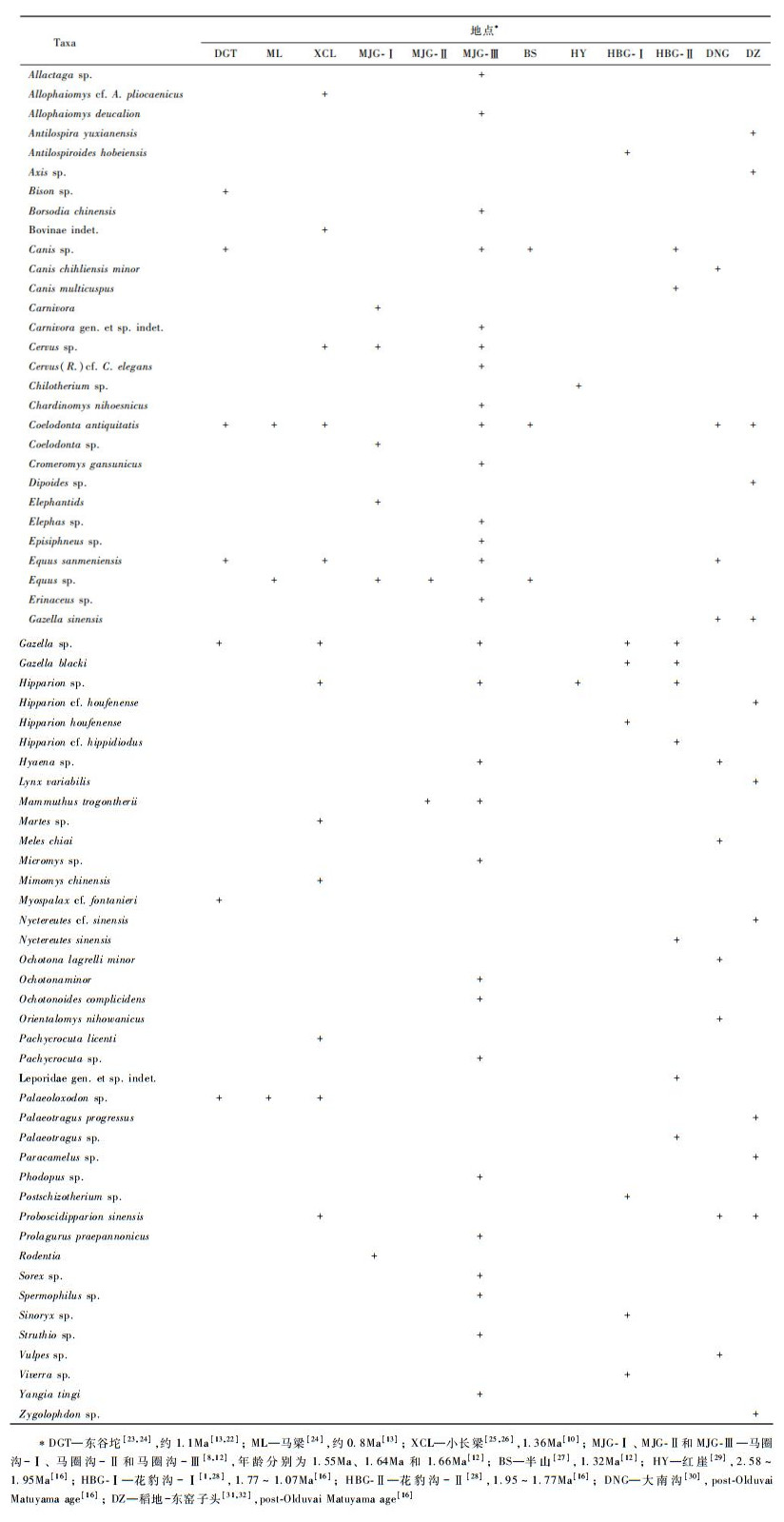② 中国科学院大学, 北京 100049;
③ 澳大利亚国立大学, 堪培拉0200;
④ 中国科学院地质与地球物理研究所, 新生代地质与环境重点实验室, 北京 100029;
⑤ 中国科学院地质与地球物理研究所, 岩石圈演化国家重点实验室, 北京 100029;
⑥ 中国科学院古脊椎动物与古人类研究所, 北京 100044)
泥河湾盆地是东亚一系列晚新生代断陷盆地之一,盆地主体位于河北省阳原县和蔚县境内,桑干河及其支流壶流河贯穿整个盆地[1, 2](图 1),盆地内发育有巨厚的河湖相沉积地层,含有丰富的哺乳动物化石和早期人类遗存,为东亚第四纪生物年代地层学及早期人类演化提供了新的视角[2]。自20世纪20年代以来,该区一直是中外地质学家、古生物学家和古人类学家研究的热点,尤其是研究东亚早期人类对高纬度地区环境适应性的重要地区,是我国研究程度最高的第四纪地层之一[1, 3~8]。近年来,泥河湾盆地的磁性地层学已开展了大量的研究工作,盆地内一系列著名旧石器遗址的年代相继得到了确定,建立了泥河湾组磁性地层年代格架,厘定了广义的泥河湾动物群的年代[2, 9~17],确定了东亚第四纪陆相生物年代学[9, 16, 18],并认识到华北地区早期人类已经能够适应高纬度地区的复杂环境变化[10~12, 19~21]。
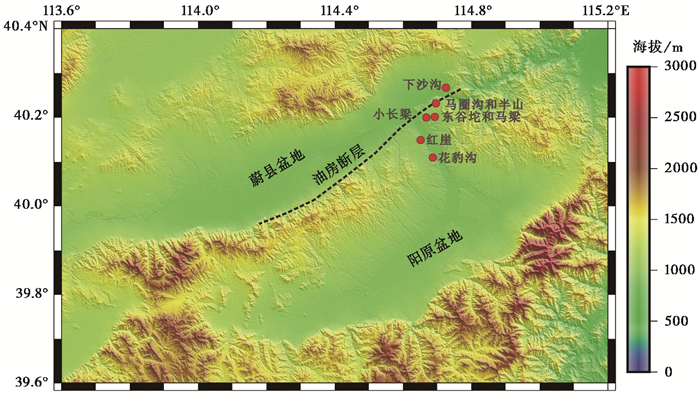
|
图 1 泥河湾盆地东部地貌图以及本文提到的主要剖面(红色点所示)地貌图资料来源于ASTER GDEM Fig. 1 Schematic map showing the eastern Nihewan Basin and the magnetostratigraphically-dated mammalian fossil sites (red solid circles) mentioned in this paper. Geomorphological data comes from ASTER GDEM |
泥河湾动物群是我国能够与欧洲维拉方期动物群直接对比的最丰富和最具代表性的一个动物群[9],它在我国第四纪动物群研究中的意义非常重要[2]。泥河湾动物群分广义和狭义,广义的泥河湾动物群(表 1)指泥河湾盆地河湖相沉积物中发现的一系列动物群,包括已有确切古地磁年龄证据的东谷坨动物群[22~24]、小长梁动物群[25, 26]、马梁动物群[24]、半山动物群[27]、马圈沟动物群[12]、花豹沟动物群[1, 28]、红崖动物群[29]及未有直接年龄证据的大南沟动物群[30]、东窑子头动物群[31, 32]和下沙沟动物群[5]等等;狭义的泥河湾动物群仅指下沙沟动物群[5]。经典的下沙沟动物群是泥河湾动物群的命名地,是泥河湾盆地走向世界的起点,其年代的确定对于完善整个泥河湾动物群的生物年代框架非常重要。
| 表 1 泥河湾盆地哺乳动物群列表 Table 1 List of mammalian faunas in the eastern Nihewan Basin |
1930年Teilhard和Piveteau[5]出版的《泥河湾哺乳动物化石》专著,首次报道的泥河湾盆地哺乳动物群主要是采自下沙沟剖面,早期研究的泥河湾哺乳动物化石主要在泥河湾村及以东的下沙沟一带发现的[1, 5, 31],随后古生物学者总结并重新修正了下沙沟动物群化石名单[1, 5, 6, 33](表 2)。下沙沟动物群(狭义的泥河湾动物群)与欧洲维拉方动物群年代相近[5, 9],准确确定其年代对于东亚陆相第四纪生物年代学具有重要意义[9, 16, 18, 33]。由于化石主要是80多年前收集于村民手中,所产化石地层岩性主要为粉砂及粉砂质粘土,沉积物天然剩余磁性较弱,磁性矿物的来源、成分和粒度组合复杂多样。因此,经典下沙沟动物群的确切年代一直没有得到解决。但仍然可以清楚地确定3个主要挖掘化石的层位,位于下沙沟剖面220~140m深度处[5]。
| 表 2 泥河湾盆地下沙沟动物群列表 Table 2 Comparison of the faunal list of the XSG mammalian fauna in the Nihewan Basin |
本文主要对含有下沙沟动物群的泥河湾河湖相沉积物进行了详细的磁性地层学和岩石磁学研究,建立了下沙沟剖面的磁极性倒转序列,准确厘定狭义泥河湾动物群的确切年代;同时结合前人已发表的泥河湾盆地中其他动物群的年龄,获得了泥河湾动物群的年代序列。
2 地质背景及采样泥河湾盆地位于华北平原与内蒙古高原的过渡带上,为晚新生代断陷盆地,盆地内发育有巨厚的上新世晚期-更新世河湖相沉积(即泥河湾层)及晚更新世-全新世风成黄土,含有丰富的哺乳动物化石和早期人类遗存[2]。泥河湾古湖自中更新世晚期-晚更新世消亡后,桑干河及其支流从西南到东北贯穿其中[1, 2, 16]。
下沙沟剖面(XSG: 40°17′03″N,114°42′57″E)位于泥河湾盆地的东缘,主要由河湖相和冲-洪积相沉积地层组成,沉积物主要为灰黄色、灰绿色粉砂质粘土、粉砂、砂质砂和砾石。剖面厚度为260m,其中化石主要发现在粉砂、砂及砾石层中。其中20世纪20年代发现的3个化石层位于剖面220~140m深度处[5]。下沙沟剖面共分两个地层单元,上部(0~122m)为冲-洪积相,主要为灰黄色粉砂质粘土、砾石夹杂细砂层;下部(122~260m)为灰黄色粉砂夹有细砂及砾石。剖面底部以东500m处的石匣剖面发育晚新近纪风成红粘土,这种地层沉积序列在距离下沙沟剖面西南约12km处的红崖剖面也有发现[16]。最早由Barbour等[34](1927)提出的泥河湾盆地上新世红粘土,在黄土高原地区又称“三趾马红粘土”[35],其时代为上新世。我们对下沙沟剖面以20~50cm间距采样,共采集定向古地磁样品658块,其中155.5~179.1m为砂砾石层,未采集样品。
3 研究方法和实验结果 3.1 磁化率各向异性岩石磁学是古地磁学、磁性地层学和环境磁学研究的基础[36~40],深入的岩石磁学研究是获取可靠古地磁数据的重要前提。对天然样品进行退磁处理以建立磁极性倒转序列之前,我们通过详细的岩石磁学方法检验下沙沟剖面古地磁记录的可靠性。利用KLY-4s卡帕桥测量样品的磁化率各向异性(Anisotropy of Magnetic Susceptibility,简称AMS),根据Jelinek[41]的方法,对15个方向的测量结果计算每个样品的磁化率张量。共测量431块样品,研究结果表明磁线理小于磁面理[42](图 2),表明磁化率各向异性椭球体是扁平的,大多数样品的最小磁化率轴接近直立并垂直于层面,且密集分布,而最大磁化率轴平缓。这些结果表明下沙沟剖面地层属于原始沉积组构,自沉积以来没有受到扰动[43~45]。
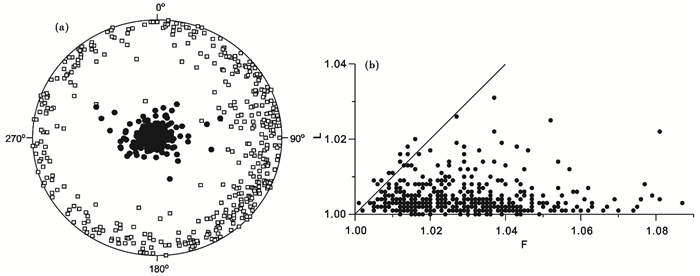
|
图 2 下沙沟剖面的磁化率各向异性[42] (a)最大磁化率主轴Kmax(方框)和最小磁化率主轴Kmin(实心圆圈)的投影图,(b)磁线理(L)和磁面理(F)的关系 Fig. 2 Anisotropy of magnetic susceptibility(AMS)of samples from the XSG section[42]. (a)Stereographic projection of principal susceptibility axes of Kmax(open squares)and Kmin(solid circles); (b)Magnetic lineation(L)versus magnetic foliation(F) |
磁化率随温度变化(χ-T)曲线被广泛应用到天然样品在加热过程中不同磁性矿物的变化特征,从而利用这些特征可识别磁性矿物的种类和粒度分布[46, 47]。χ-T曲线用捷克Agico公司生产的MFK1-FA(967赫兹)卡帕桥测量,温度控制系统为CS-4,在氩气环境中加热。图 3所示下沙沟剖面的所有样品加热到585℃左右时磁化率都急剧降低,显示了磁铁矿的居里温度[42]。部分样品的加热曲线在300~450℃时磁化率降低,一般是亚铁磁性的磁赤铁矿向弱磁性的赤铁矿转化的信号[48]。弱磁性的赤铁矿在χ-T曲线的特征通常会被强磁性的磁铁矿或者磁赤铁矿的贡献所掩盖而变得很不明显,通过大量系统热退磁实验表明,泥河湾盆地中赤铁矿也是重要的剩磁载体[13, 14, 16, 19, 21, 42]。大多数样品的冷却曲线都显示出磁铁矿的特征并伴随着磁化率的显著升高(图 3)[42],这主要由含铁硅酸盐/粘土矿物在加热过程中转化成磁铁矿引起[47, 49]。
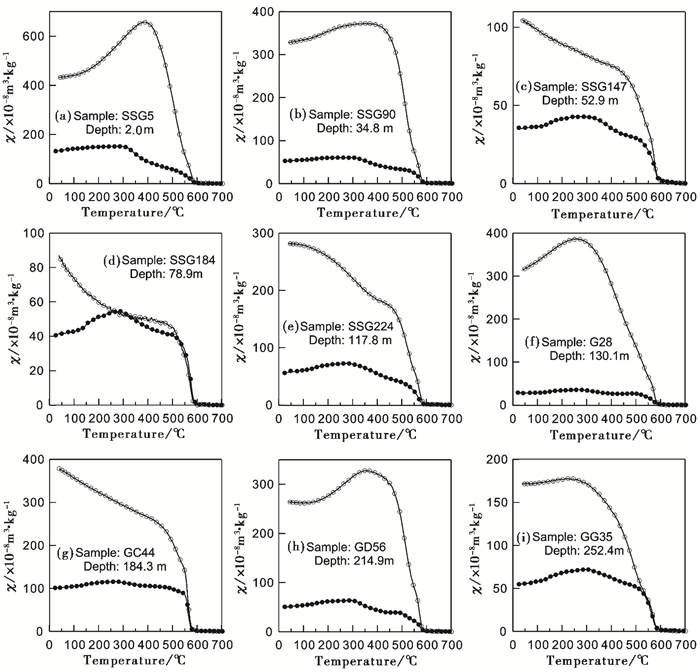
|
图 3 下沙沟剖面典型样品的磁化率随温度变化(χ-T)曲线[42]实心圆圈表示加热曲线,空心圆圈表示冷却曲线 Fig. 3 High-temperature magnetic susceptibility(χ-T)of representative samples of the XSG section[42] The solid(open)circles represent heating(cooling)curves in χ-T curves |
磁滞参数(包括饱和剩余磁化强度Mrs、饱和磁化强度Ms、矫顽力Bc和剩磁矫顽力Bcr)、等温剩磁(IRM)获得曲线及其在反向场中的退磁用美国普林斯顿仪器公司生产的MicroMag 3900型振动样品磁力仪测量。下沙沟剖面代表性样品的磁滞回线在300mT以下闭合[42](图 4),所有样品显示出相似的IRM获得曲线,且在100mT及300mT已获得了饱和剩磁的66 %~87 %和92 %~98 % [42](图 5),300mT以下达到饱和,S比值(S-ratio)[50]接近于1,这些特征说明沉积物的剩磁载体主要为低矫顽力的磁性矿物,结合χ-T曲线[42](图 3),可以确定这种磁性矿物是磁铁矿。大部分样品的剩磁比(Mrs/Ms)和矫顽力比(Bcr/Bc)在Day氏图[51]上的投影主要落在假单畴(PSD)区域,表明沉积物中磁铁矿的平均粒度主要在PSD范围内[42](图 6)。

|
图 4 下沙沟剖面典型样品顺磁校正后的磁滞回线[42]最大外加场为±1.0T;Mrs、Ms、Bc和Bcr分别表示饱和剩余磁化强度、饱和磁化强度、矫顽力、剩磁矫顽力 Fig. 4 Hysteresis loops of representative samples of the XSG section[42]. The hysteresis loops were measured in fields up to±1.0T. Mrs, Ms, Bc and Bcr indicate saturation remanent magnetization, saturation magnetization, coercivity and remanent coercivity, respectively |
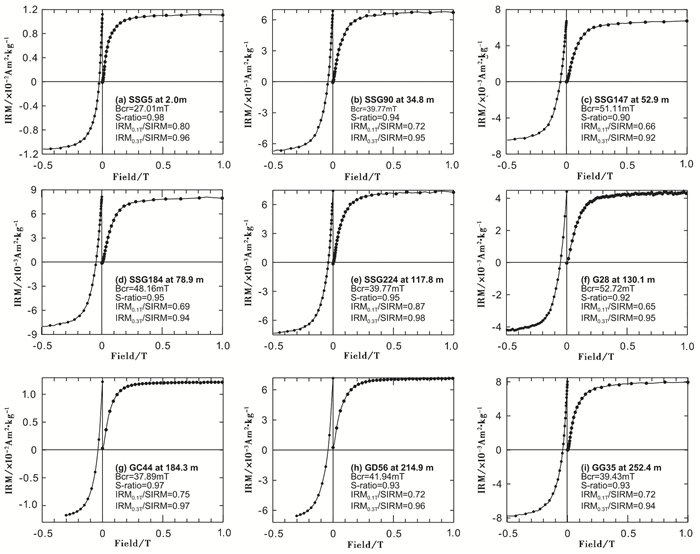
|
图 5 下沙沟剖面典型样品的等温剩磁获得曲线及其反向场退磁曲线[42]等温剩磁获得曲线中将1.0T获得的剩磁视为饱和剩磁,S-ratio=-IRM-300mT/SIRM[50] Fig. 5 Saturation isothermal remanent magnetization(SIRM)acquisition and its back-field demagnetization curves of representative samples of the XSG section[42]. The IRM acquired in a field of 1.0 Tesla(T)was regarded as SIRM. S-ratio=-IRM-300mT/SIRM[50] |
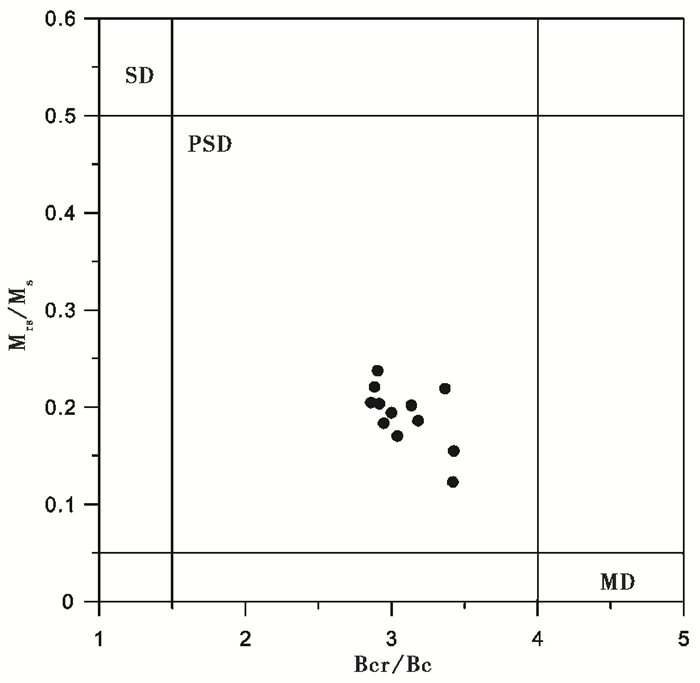
|
图 6 下沙沟剖面典型样品的磁滞参数的Day-氏图[42] SD、PSD和MD分别代表单畴、假单畴和多畴 Fig. 6 Day diagram of hysteresis parameters for representative samples of the XSG section[42]. SD, single domain; PSD, pseudo-single domain; MD, multi-domain |
在详细的岩石磁学分析基础上,进行了系统的退磁实验。剩磁测量采用安装在零磁空间( & 300 nT)的2G-760三轴超导磁力仪上完成。首先,对于下沙沟剖面的658块样品使用MMTD80型热退磁炉进行13~21步退磁,585℃以下采用25~50℃的间隔,585℃以上至685℃,采用10~15℃的退磁间距;然后,对于加热过程中易发生矿物变化的样品,利用一套平行样品先进行80℃和150℃热退磁后,再采用12步最大场为60mT的交变退磁。下沙沟剖面样品的天然剩磁(NRM)的强度大约为10-2~10-4A/m。典型样品的系统退磁结果的正交投影图[52]见图 7[42],两种退磁方法都能去掉一种或者两种软磁组分,得到特征剩磁(Characteristic Remanent Magnetization,简称ChRM)。有些样品退磁到585~630℃[42](图 7a和7c~7g),即可获得ChRM,有些样品需要退磁到685℃[42](图 7b、7j和7k)或者60mT[42](图 7h、7i和7l)。退磁结果表明下沙沟剖面的剩磁载体主要为部分氧化的磁铁矿及赤铁矿。数据分析时,至少采用4个连续的退磁点,并且最大角度偏差(Maximum Angular Deviation,简称MAD)小于15℃(图 8d)。利用“最小二乘法拟合”(least-squares fitting)方法[53]计算每个样品的ChRM方向。下沙沟剖面共477(72.5 %)块定向样品获得了可靠的ChRM。根据获得的ChRM方向计算样品的虚地磁极(Virtual Geomagnetic Pole,简称VGP)纬度,依VGP纬度建立下沙沟剖面的磁极性倒转序列[42](图 8f)。
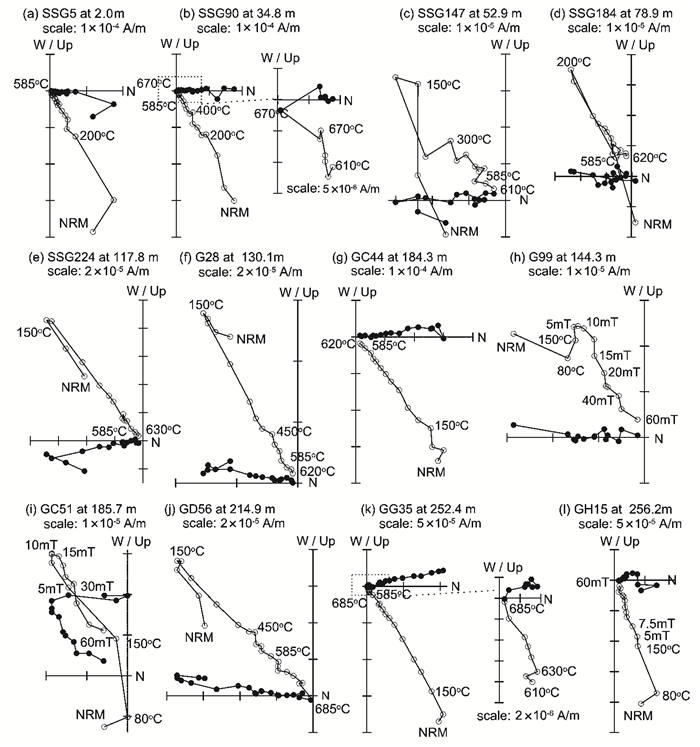
|
图 7 下沙沟剖面典型样品的系统退磁结果正交投影图[42]实心和空心圆圈线分别表示水平面和垂直面的投影,℃和mT分别表示温度和磁场,NRM为天然剩磁 Fig. 7 Orthogonal vector projections of representative progressive thermal demagnetization of the selected samples from the XSG section[42]. Solid(open)circles represent the horizontal(vertical)planes. The numbers refer to temperatures in ℃(a~g, j, and k) or both temperatures in ℃ and fields in mT(h, i, and l). NRM is the natural remanent magnetization |

|
图 8 下沙沟剖面的岩性及磁极性序列[42] (a)岩性,(b)磁偏角,(c)磁倾角,(d)最大角偏差(MAD),(e)虚地磁极纬度,(f)地磁极性序列,(g)标准地磁极性序列[54~57] J=Jaramillo,O=Olduvai,P=Punaruu,CM=Cobb Mountain,R=Reunion;N=正极性,R=负极性,e=地磁极性漂移;(f)中的阴影表示没有采样 Fig. 8 Lithostratigraphy and magnetostratigraphy of the XSG section[42]. (a)Lithology; (b)Declination(Dec.); (c)Inclination(Inc.); (d)Maximum angular deviation(MAD); (e)Virtual geomagnetic pole(VGP)latitude; (f)Magnetic polarity zonation; (g)Geomagnetic polarity timescale(GPTS)[54~57]. J, Jaramillo; O, Olduvai; P, Punaruu; CM, Cobb Mountain; R, Reunion. N, normal polarity; R, reverse polarity; e, geomagnetic excursion. The hatched area in (f) indicates interval with no data |
下沙沟剖面所测样品记录了10个极性带(magnetozones)[42](图 8f),其中6个正极性带,它们分别是N1(0~44.8m)、N2(91.3~103m)、N3(151.7~155.5m)、N4(179.1~188.9m)、N5(194.5~198.3m)和N6(243.9~258m);4个负极性带,它们分别是R1(44.8~91.3m)、R2(103~151.7m)、R3(188.9~194.5m)和R4(198.3~243.9m);另外,在N2和R2极性带中记录了两个地磁漂移事件,它们分别是e1(96.1~98.7m)和e2(138.6~140.6m)(图 8)。
4 讨论 4.1 下沙沟剖面的极性与标准地磁极性对比泥河湾盆地的河湖相沉积记录了上新世-更新世的构造-沉积过程,上新世时期盆地开始沉陷接受沉积[1]。油房断层位于小长梁和马圈沟旧石器遗址之间,该断层对泥河湾古湖初期的形成具有重要意义[16]。晚更新世或者全新世黄土沉积在泥河湾层之上[10, 12, 16, 19],距离下沙沟剖面底部以东500m的石匣地区,出露典型的上新世风成红粘土(另文发表),类似的沉积序列在距离下沙沟剖面西南约12km处的红崖剖面中也有发现[16]。传统上,泥河湾动物群与欧洲维拉方动物群的年代相对应[5, 9],属于早更新世动物群。因此,地层学及生物年代学为下沙沟剖面地层对比提供了年代制约。
我们将磁性地层学和沉积学有机结合,同时结合生物年代学证据,将下沙沟剖面所得极性与地磁极性年表[54~59]对比。尽管N3和N4之间有沉积间断,N1、N2、N3和N4、N5、N6分别对应于布容正极性时(Brunhes normal chron)、贾拉米洛正极性亚时(Jaramillo normal subchron)、奥杜威正极性亚时(Olduvai normal subchron)、留尼旺正极性亚时(Reunion normal subchron)、高斯正极性时(Gauss normal chron),R1、R2、R3和R4对应于松山负极性时(Matuyama reverse chron)。另外,N2中的e1事件有可能对应于贾拉米洛正极性亚时期间的一个地磁漂移[55, 56](图 8f);至于R2中的e2事件,很难将它与奥杜威正极性亚时和贾拉米洛正极性亚时事件之间的某个地磁漂移对比,例如: Cobb Mountain和Punaruu地磁漂移。
4.2 下沙沟动物群的年代将高分辨率的磁极性地层学研究与沉积地层学及生物年代学证据相结合,我们可以准确确定下沙沟剖面河湖相地层沉积了自高斯正极性时晚期、松山负极性时至布容正极性时的沉积物。红粘土沉积物以上14m处,高斯/松山(Gauss/Matuyama)地磁极性倒转界限,即上新世/更新世(Pliocene/Pleistocene)界限位于下沙沟剖面底部[42](图 8)。因此,下沙沟剖面中泥河湾层的沉积稍早于高斯/松山地磁极性倒转界限,这些沉积特征与距离下沙沟剖面西南约12km的红崖剖面[16](图 1和9)一致。由于下沙沟动物群主要发现在该剖面的220~140m深度处[5],跨越了留尼旺正极性亚时及奥杜威正极性亚时。根据沉积速率推算,从而确定了下沙沟动物群的年代大约为2.2~1.7Ma。
典型的下沙沟动物群(狭义的泥河湾动物群)的动物名单见表 2[5, 6, 33]。在这些化石名单中,将近一半的动物名单在广义的泥河湾动物群(表 1)中出现[30~32],其年代大约为高斯/松山与松山/布容(Matuyama/Brunhes)地磁倒转界限之间(图 10)。

|
图 10 泥河湾盆地早更新世哺乳动物群已有磁性地层年代数据在地磁极性柱[54]上投放位置J=Jaramillo,O=Olduvai,G=Gauss;动物群名字缩写见表 1 Fig. 10 A composite diagram with all magnetostratigraphically dated mammalian faunas of the Early Pleistocene age in the Nihewan Basin within the framework of the geomagnetic polarity timescale[54]. J, Jaramillo; O, Olduvai. G, Gauss. See Table 1 for abbreviations of faunal sites |
邱占祥[9]对下沙沟动物群与欧洲维拉方经典动物群中属级相同的20种哺乳动物进行形态和进化水平的对比发现: 1)有11个种在进化水平上与维拉方早期的Olivola动物群的成员最接近,它们是Vulpes sp.、Canis chihliensis、Canis chihliensis palmidens、Canis chihliensis minor、Ursus cf. U. etruscus、Pachycrocuta licenti、Chasmaporthetes cf. ossifragus、 Megantereon nihowanensis、Homotherium cf. H. crenatidens、 Sus sp.及Eucladoceros boulei,其年代大约为1.8Ma;2)有4种动物,Nyctereutes sinensis、Lynx shansius、Pseudodama elagans及Megalovis piveteaui,可以与维拉方晚期的Seneze动物群相比较;3)有两种动物,Borsodia chinensis和Meles chiai有可能与Olivola动物群相近;4)剩下的3种动物,Sivapanthera pleistocaenus(有可能是一个新种)、Equus sanmeniensis和E. teilhardi的时代意义不很明确,它们可能属于不同的进化支系。从上述20种动物的进化水平,邱占祥[9]得出下沙沟动物群与欧洲维拉方早期的Olivola动物群最为接近,其年代大约为1.8Ma。因此,下沙沟动物群的年代是基于磁极性地层学和生物年代学的基础上得出的。
4.3 泥河湾动物群年代序列详细的磁性地层学定年为泥河湾动物群的年代提供了相对独立的年代制约,下沙沟动物群位于留尼旺正极性亚时及奥杜威正极性亚时之间的松山负极性时中(图 8f和图 9),其年代约为2.2~1.7Ma。结合前人研究结果[2, 10, 12, 13, 16],马圈沟-Ⅰ、马圈沟-Ⅱ、马圈沟-Ⅲ、半山、小长梁、东谷坨、马梁、红崖、花豹沟-Ⅰ、花豹沟-Ⅱ等这些动物群的年代位于松山负极性时(图 9)。更精确的说,马梁动物群处于松山/布容界限下部,其年代为0.8Ma[13];东谷坨动物群处于贾拉米洛正极性亚时的下部[13];小长梁动物群位于奥杜威正极性亚时与贾拉米洛正极性亚时之间[10, 12];马圈沟-Ⅰ、马圈沟-Ⅱ、马圈沟-Ⅲ和花豹沟-Ⅰ等动物群靠近奥杜威正极性亚时上部[12, 16];花豹沟-Ⅱ动物群位于奥杜威正极性亚时内[16];红崖动物群处于高斯正极性时与奥杜威正极性亚时之间的松山负极性时[16]。因此,马梁与东谷坨动物群的年代约为0.8与1.1Ma[13],半山、小长梁、马圈沟-Ⅰ、马圈沟-Ⅱ、马圈沟-Ⅲ等动物群的年代分别约为1.32Ma、1.36Ma、1.55Ma、1.64Ma和1.66Ma[10, 12],花豹沟-Ⅰ、花豹沟-Ⅱ、红崖等动物群的年代约为1.77~1.07Ma、1.95~1.77Ma和2.58~1.95Ma[16]。
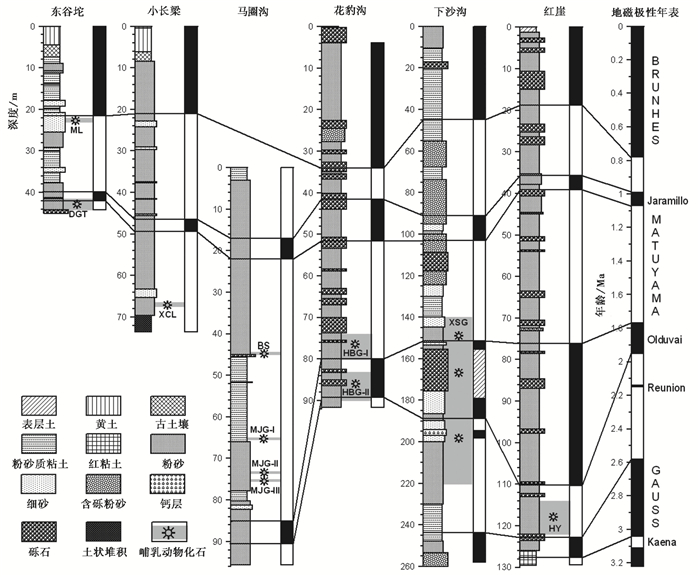
|
图 9 泥河湾盆地中含有早更新世动物群剖面的岩性地层及磁极性地层与标准地磁极性综合对比[54]岩性地层及磁极性地层来源于以下资料:小长梁[10],东谷坨和马梁[13],马圈沟和半山[12],红崖和花豹沟[16],下沙沟[42] Fig. 9 A synthetic diagram related the magnetostratigraphically dated sections in the eastern Nihewan Basin, which contain the Early Pleistocene mammalian fauna sites, to the geomagnetic polarity time scale(GPTS)[54]. Data sources of the lithostratigraphy and magnetostratigraphy:XCL[10], DGT and ML[13], MJG and BS[12], HY and HBG[16] and XSG[42] |
综上所述,将泥河湾盆地已有年代数据的动物群投在标准地磁极性柱上(图 10),获得了泥河湾动物群的年代序列,泥河湾动物群正好投在高斯/松山和松山/布容地磁倒转界限(2.58~0.78Ma)之间,也就是泥河湾动物群的年代序列为2.6~0.8Ma,这一研究结果完善了泥河湾盆地的生物年代学框架。由于大南沟和东窑子头动物群的确切年代未知,这两个动物群不在泥河湾动物群序列范围内,其磁性地层学定年将另文发表。
5 结论岩石磁学及古地磁学实验表明,下沙沟剖面河湖相沉积物的特征剩磁载体为部分氧化的磁铁矿和赤铁矿;高分辨率的磁性地层学研究表明下沙沟河湖相沉积物的极性为高斯正极性时晚期、松山负极性时和布容正极性时,下沙沟动物群层位跨越留尼旺正极性亚时和奥杜威正极性亚时,从而确定其年代约为2.2~1.7Ma。上新世/更新世界限(也就是高斯/松山地磁倒转界限)位于下沙沟剖面的底部。
结合前人研究结果,将泥河湾盆地已有年代数据的动物群标注在地磁极性年表上,获得了泥河湾动物群的年代序列,表明泥河湾动物群位于高斯/松山和松山/布容地磁倒转界限之间(2.58~0.78Ma),因此泥河湾动物群的年代为2.6~0.8Ma,这一研究结果完善了泥河湾盆地的生物年代学框架。
致谢: 所有实验均在中国科学院地质与地球物理研究所古地磁与年代学实验室完成,特此感谢;同时感谢《第四纪研究》编辑杨美芳为完善本文做出的努力。
| 1 |
周廷儒, 李华章, 刘清泗, 等.
泥河湾盆地新生代古地理研究 . 北京: 科学出版社, 1991 : 1 ~162.
Zhou Tingru, Li Huazhang, Liu Qingsi, et al. Cenozoic Paleogeography of the Nihewan Basin. Beijing: Science Press, 1991 : 1 ~162. (  0) 0)
|
| 2 |
朱日祥, 邓成龙, 潘永信. 泥河湾盆地磁性地层定年与早期人类演化.
第四纪研究,2007, 27 (6) : 922~944.
Zhu Rixiang, Deng Chenglong, Pan Yongxin. Magnetochronology of the fluvio-lacustrine sequences in the Nihewan Basin and implications for early human colonization of Northeast Asia. Quaternary Sciences,2007, 27 (6) : 922~944. (  0) 0)
|
| 3 |
Barbour G B. Preliminary observation in Kalgan area.
Bulletin of the Geological Society of China,1924, 3 (2) : 167~168.
( 0) 0)
|
| 4 |
Barbour G B. The deposits of the Sankanho Valley.
Bulletin of Geological Society of China,1925, 4 : 53~55.
( 0) 0)
|
| 5 |
Teilhard de Chardin P, Piveteau J. Les mammiferes fossiles de Nihowan(Chine).
Annales de Paleontologie,1930, 19 : 1~134.
( 0) 0)
|
| 6 |
陈茂南.
泥河湾地层的研究 . 北京: 海洋出版社, 1988 : 1 ~145.
Chen Maonan. Study on the Nihewan Beds. Beijing: China Ocean Press, 1988 : 1 ~145. (  0) 0)
|
| 7 |
谢飞.
泥河湾 . 北京: 文物出版社, 2006 : 1 ~330.
Xie Fei. Nihewan. Beijing: Cultural Relics Publishing House, 2006 : 1 ~330. (  0) 0)
|
| 8 |
谢飞, 李琚, 刘连强.
泥河湾旧石器文化 . 石家庄: 花山文艺出版社, 2006 : 1 ~278.
Xie Fei, Li Ju, Liu Lianqiang. Paleolithic Archeology in the Nihewan Basin. Shijiazhuang: Huashan Literature & Arts Press, 2006 : 1 ~278. (  0) 0)
|
| 9 |
邱占祥. 泥河湾盆地哺乳动物群与中国第四系下限.
第四纪研究,2000, 20 (2) : 142~154.
Qiu Zhanxiang. Nihewan fauna and Q/N boundary in China. Quaternary Sciences,2000, 20 (2) : 142~154. (  0) 0)
|
| 10 |
Zhu R X, Hoffman K A, Potts R, et al. Earliest presence of humans in Northeast Asia.
Nature,2001, 413 : 413~417.
doi:10.1038/35096551 ( 0) 0)
|
| 11 |
Zhu R X, An Z S, Potts R, et al. Magnetostratigraphic dating of early humans in China.
Earth Science Reviews,2003, 61 (3~4) : 341~359.
( 0) 0)
|
| 12 |
Zhu R X, Potts R, Xie F, et al. New evidence on the earliest human presence at high northern latitudes in Northeast Asia.
Nature,2004, 431 : 559~562.
doi:10.1038/nature02829 ( 0) 0)
|
| 13 |
Wang H Q, Deng C L, Zhu R X, et al. Magnetostratigraphic dating of the Donggutuo and Maliang Paleolithic sites in the Nihewan Basin, North China.
Quaternary Research,2005, 64 (1) : 1~11.
doi:10.1016/j.yqres.2005.04.001 ( 0) 0)
|
| 14 |
Wang X S, Yang Z Y, Løvlie R, et al. High-resolution magnetic stratigraphy of fluvio-lacustrine succession in the Nihewan Basin, China.
Quaternary Science Reviews,2004, 23 (9~10) : 1187~1198.
( 0) 0)
|
| 15 |
Wang X S, Løvlie R, Su P, et al. Magnetic signature of environmental change reflected by Pleistocene lacustrine sediments from the Nihewan Basin, North China.
Palaeogeography, Palaeoclimatology, Palaeoecology,2008, 260 (3~4) : 452~462.
( 0) 0)
|
| 16 |
Deng C L, Zhu R X, Zhang R, et al. Timing of the Nihewan formation and faunas.
Quaternary Research,2008, 69 (1) : 77~90.
doi:10.1016/j.yqres.2007.10.006 ( 0) 0)
|
| 17 |
Li H M, Yang X Q, Friedrich H, et al. High resolution magnetostratigraphy and deposition cycles in the Nihewan Basin(North China)and their significance for stone artifact dating.
Quaternary Research,2008, 69 (2) : 250~262.
doi:10.1016/j.yqres.2007.11.002 ( 0) 0)
|
| 18 |
邓涛. 中国新近纪哺乳动物生物年代学.
古脊椎动物学报,2006, 44 (2) : 143~163.
Deng Tao. Chinese Neogene mammal biochronology. Vertebrata PalAsiatica,2006, 44 (2) : 143~163. (  0) 0)
|
| 19 |
Deng C L, Wei Q, Zhu R X, et al. Magnetostratigraphic age of the Xiantai Paleolithic site in the Nihewan Basin and implications for early human colonization of Northeast Asia.
Earth and Planetary Science Letters,2006, 244 (1~2) : 336~348.
( 0) 0)
|
| 20 |
Deng C L, Xie F, Liu C C, et al. Magnetochronology of the Feiliang Paleolithic site in the Nihewan Basin and implications for early human adaptability to high northern latitudes in East Asia.
Geophysical Research Letters,2007, 34 (14) : L14301.
doi:10.1029/2007GL030335 ( 0) 0)
|
| 21 |
Liu P, Deng C L, Li S H, et al. Magnetostratigraphic dating of the Huojiadi Paleolithic site in the Nihewan Basin, North China.
Palaeogeography, Palaeoclimatology, Palaeoecology,2010, 298 (3~4) : 399~408.
( 0) 0)
|
| 22 |
李华梅, 王俊达.中国北方几个典型地质剖面的磁性地层学研究.见:刘东生主编.中国第四纪地质与环境.北京:海洋出版社, 1982. 33~37
Li Huamei, Wang Junda. Magnetostratigraphic study of several typical geologic sections in North China. In:Liu Tungsheng eds. Quaternary Geology and Environment of China. Beijing:China Ocean Press, 1982. 33~37 (  0) 0)
|
| 23 |
卫奇. 东谷坨旧石器初步观察.
人类学学报,1985, 4 (4) : 289~300.
Wei Qi. Preliminary observation of Donggutuo palaeolithics. Acta Anthropologica Sinica,1985, 4 (4) : 289~300. (  0) 0)
|
| 24 |
Wei Qi.
Geologic sequence of the archaeological sites in the Nihewan Basin, North China. In:Institute of Vertebrate Paleontology and Paleoanthropology, Chinese Academy of Sciences ed. Contributions to the ⅩⅢ INQUA. Beijing: Beijing Scientific and Technological Publishing House, 1991 : 61 ~73.
( 0) 0)
|
| 25 |
尤玉柱, 汤英俊, 李毅. 泥河湾旧石器的发现.
中国第四纪研究,1980, 5 (1) : 1~13.
You Yuzhu, Tang Yingjun, Li Yi. Paleolithic artifacts from Nihewan Formation. Quaternaria Sinica,1980, 5 (1) : 1~13. (  0) 0)
|
| 26 |
汤英俊, 李毅, 陈万勇. 河北阳原小长梁遗址哺乳类化石及其时代.
古脊椎动物学报,1995, 33 (1) : 74~83.
Tang Yingjun, Li Yi, Chen Wanyong. Mammalian fossils and the age of Xiaochangliang paleolithic site of Yangyuan, Hebei. Vertebrata PalAsiatica,1995, 33 (1) : 74~83. (  0) 0)
|
| 27 |
卫奇. 泥河湾盆地半山早更新世旧石器遗址初探.
人类学学报,1994, 13 (3) : 223~238.
Wei Qi. Banshan Paleolithic site from the Lower Pleistocene in the Nihewan Basin in Northern China. Acta Anthropologica Sinica,1994, 13 (3) : 223~238. (  0) 0)
|
| 28 |
王安德. 泥河湾地区上新世哺乳动物群的发现及其意义.
科学通报,1982 (4) : 227~229.
Wang Ande. Discovery of the Pliocene mammalian faunas from the Nihewan region and its significance. Chinese Science Bulletin,1982 (4) : 227~229. (  0) 0)
|
| 29 |
黄万坡, 汤英俊. 泥河湾盆地晚新生代几个地层剖面的观察.
古脊椎动物与古人类,1974, 12 (2) : 99~108.
Huang Wanpo, Tang Yingjun. Observation on the Later Cenozoic of Nihewan Basin. Vertebrata PalAsiatica,1974, 12 (2) : 99~108. (  0) 0)
|
| 30 |
李毅. 河北蔚县大南沟哺乳动物化石及其地层时代.
古脊椎动物学报,1984, 22 (1) : 60~68.
Li Yi. The early Pleistocene mammalian fossils of Danangou, Yuxian, Hebei. Vertebrata PalAsiatica,1984, 22 (1) : 60~68. (  0) 0)
|
| 31 |
汤英俊. 河北蔚县早更新世哺乳动物化石及其在地层划分上的意义.
古脊椎动物与古人类,1980, 18 (4) : 314~323.
Tang Yingjun. Note on a small collection of Early Pleistocene mammalian fossils from northern Hebei. Vertebrata PalAsiatica,1980, 18 (4) : 314~323. (  0) 0)
|
| 32 |
汤英俊, 计宏祥. 河北省蔚县上新世-早更新世间的一个过渡哺乳动物群.
古脊椎动物与古人类,1983, 21 (3) : 245~254.
Tang Yingjun, Ji Hongxiang. A Pliocene-Pleistocene transitional fauna from Yuxian, northern Hebei. Vertebrata PalAsiatica,1983, 21 (3) : 245~254. (  0) 0)
|
| 33 |
Qiu Z X, Qiu Z D. Chronological sequence and subdivision of Chinese Neogene mammalian faunas.
Palaeogeography, Palaeoclimatology, Palaeocelogy,1995, 116 (1~2) : 41~70.
( 0) 0)
|
| 34 |
Barbour G B, Licent E, Teilhard de Chardin P. Geological study of the deposits of the Sangkanho Basin.
Bulletin of Geological Society of China,1927, 5 (2~4) : 263~278.
( 0) 0)
|
| 35 |
Theilard de Chardin P, Young C C. Preliminary observation on the pre-loessic and post-Ponian Formation in western Shanxi and northern Shensi.
Memoir Geological Survey China (Series A),1930, 8 : 1~54.
( 0) 0)
|
| 36 |
Dunlop D J, Ozdemir O.
Rock Magnetism:Fundamentals and Frontiers. Cambridge: Cambridge University Press, 1997 .
( 0) 0)
|
| 37 |
脱世博, 方小敏, 宋春晖, 等. 青藏高原东北部西宁盆地晚渐新世-早中新世沉积物岩石磁学特征及其古环境意义.
第四纪研究,2013, 33 (5) : 829~838.
Tuo Shibo, Fang Xiaomin, Song Chunhui, et al. Rock magnetic characteristics of the Late Oligocene to Early Miocene sediments in the Xining Basin, northeastern Tibetan Plateau. Quaternary Sciences,2013, 33 (5) : 829~838. (  0) 0)
|
| 38 |
胥勤勉, 袁桂邦, 秦雅飞, 等. 滦河三角洲南部MT04孔磁性地层研究及其构造与气候耦合关系的探讨.
第四纪研究,2014, 34 (3) : 540~552.
Xu Qinmian, Yuan Guibang, Qin Yafei, et al. Magnetostratigraphy and discussion of coupling relationship between tectonic movement and climate change of MT04 borehole in southern Luanhe River delta. Quaternary Sciences,2014, 34 (3) : 540~552. (  0) 0)
|
| 39 |
程瑜, 乔彦松, 刘宗秀, 等. 甘肃灵台邵寨红粘土的磁性地层及其色度记录.
第四纪研究,2014, 34 (2) : 391~398.
Cheng Yu, Qiao Yansong, Liu Zongxiu, et al. Magnetostratigraphy and chorma records of a red clay formation near Lingtai County of Gansu Province. Quaternary Sciences,2014, 34 (2) : 391~398. (  0) 0)
|
| 40 |
陈皎杰, 刘焱光, 葛淑兰, 等. 末次盛冰期以来兴凯湖的古环境演变——基于地磁场长期变化的年龄框架.
第四纪研究,2014, 34 (3) : 528~539.
Chen Jiaojie, Liu Yanguang, Ge Shulan, et al. Paleoenvironment evolution of the Lake Khanka since the Last Glacial Maximum:Age model reconstructed by secular variation of geomagnetic field. Quaternary Sciences,2014, 34 (3) : 528~539. (  0) 0)
|
| 41 |
Jelinek V. Statistical processing of anisotropy of magnetic-susceptibility measured on groups of specimens.
Studia Geophysica et Geodaetica,1978, 22 (1) : 50~62.
doi:10.1007/BF01613632 ( 0) 0)
|
| 42 |
Liu P, Deng C L, Li S H, et al. Magnetostratigraphic dating of the Xiashagou Fauna and implication for sequencing the mammalian faunas in the Nihewan Basin, North China.
Palaeogeography, Palaeoclimatology, Palaeoecology,2012 (315~316) : 75~85.
( 0) 0)
|
| 43 |
Vlag P, Thouveny N, Williamson D, et al. Evidence for a geomagnetic excursion recorded in the sediments of Lac St Front, France:A link with the Laschamp excursion.
Journal of Geophysical Research:Solid Earth,1996, 101 (B12) : 28211~28230.
doi:10.1029/96JB02096 ( 0) 0)
|
| 44 |
Zhu R X, Coe R S, Zhao X X. Sedimentary record of two geomagnetic excursions within the last 15, 000 years in Beijing, China.
Journal of Geophysical Research:Solid Earth,1998, 103 (B12) : 30323~30333.
doi:10.1029/98JB02836 ( 0) 0)
|
| 45 |
王红强. 泥河湾盆地东谷坨剖面磁性特征及环境意义.
第四纪研究,2007, 27 (6) : 1081~1091.
Wang Hongqiang. Magnetic properties of lacustrine sediments at the Donggutuo section in the Nihewan Basin and their environmental significance. Quaternary Sciences,2007, 27 (6) : 1081~1091. (  0) 0)
|
| 46 |
Roberts A P, Cui Y L, Verosub K L. Wasp-waisted hysteresis loops:Mineral magnetic characteristics and discrimination of components in mixed magnetic systems.
Journal of Geophysical Research:Solid Earth,1995, 100 (B9) : 17909~17924.
doi:10.1029/95JB00672 ( 0) 0)
|
| 47 |
Deng C L, Zhu R X, Jackson M J, et al. Variability of the temperature-dependent susceptibility of the Holocene eolian deposits in the Chinese Loess Plateau:A pedogenesis indicator.
Physics and Chemistry of the Earth, Part A: Solid Earth and Geodesy,2001, 26 (11~12) : 873~878.
( 0) 0)
|
| 48 |
Stacey F D, Banerjee S K.
The Physical Principles of Rock Magnetism. New York: Elsevier, 1974 : 1 ~195.
( 0) 0)
|
| 49 |
Liu Q S, Deng C L, Yu Y J, et al. Temperature dependence of magnetic susceptibility in an argon environment:Implications for pedogenesis of Chinese loess/palaeosols.
Geophysical Journal International,2005, 161 (1) : 102~112.
doi:10.1111/gji.2005.161.issue-1 ( 0) 0)
|
| 50 |
King J W, Channell J E T. Sedimentary magnetism, environmental magnetism, and magnetostratigraphy. U. S. National Report to International Union of Geodesy and Geophysics 1987~1990.
Reviews of Geophysics,1991, 29 (Suppl.) : 358~370.
( 0) 0)
|
| 51 |
Day R, Fuller M, Schmidt V A. Hysteresis properties of titanomagnetites:Grain-size and compositional dependence.
Physics of the Earth and Planetary Interiors,1977, 13 (4) : 260~267.
doi:10.1016/0031-9201(77)90108-X ( 0) 0)
|
| 52 |
Zijderveld J D A.
demagnetization in rocks:Analysis of results. In:Collinson D W, Creer K M, Runcorn S K eds. Methods in Paleomagnetism. New York: Elsevier, 1967 : 254 ~286.
( 0) 0)
|
| 53 |
Kirschvink J L. The least-squares line and plane and the analysis of paleomagnetic data.
Geophysical Journal of the Royal Astronomical Society,1980, 62 (3) : 699~718.
doi:10.1111/gji.1980.62.issue-3 ( 0) 0)
|
| 54 |
Cande S C, Kent D V. Revised calibration of the geomagnetic polarity timescale for the Late Cretaceous and Cenozoic.
Journal of Geophysical Research,1995, 100 (B4) : 6093~6095.
doi:10.1029/94JB03098 ( 0) 0)
|
| 55 |
Channell J E T, Mazaud A, Sullivan P, et al. Geomagnetic excursions and paleointensities in the Matuyama Chron at Ocean Drilling Program Sites 983 and 984(Iceland basin).
Journal of Geophysical Research,2002, 107 (B6) : 2114.
doi:10.1029/2001JB000491 ( 0) 0)
|
| 56 |
Laj C, Channell J E T. Geomagnetic excursions. In:Kono M eds. Treatise in Geophysics.
Geomagnetism, Encyclopedia of Geophysics,2007, 5 (10) : 373~416.
( 0) 0)
|
| 57 |
Singer B S, Hoffman K A, Chauvin A, et al. Dating transitionally magnetized lavas of the late Matuyama Chron:Toward a new Ar40/Ar39 timescale of reversals and events.
Journal of Geophysical Research:Solid Earth,1999, 104 (B1) : 679~693.
doi:10.1029/1998JB900016 ( 0) 0)
|
| 58 |
Singer B S, Brown L L, Rabassa J O, et al. 40Ar/39Ar chronology of Late Pliocene and Early Pleistocene geomagnetic and glacial events in Southern Argentina. In:Channell J E T, Kent D V, Lowrie W eds. Timescales of the Paleomagnetic Field. American Geophysical Union.
Geophysical Monograph,2004, 145 : 175~190.
( 0) 0)
|
| 59 |
Singer B S, Jicha B R, Kirby B T. Ar40/Ar39 dating links Albuquerque volcanoes to the Pringle Falls excursion and the geomagnetic instability time scale.
Earth and Planetary Science Letters,2008, 267 (3~4) : 584~595.
( 0) 0)
|
② University of Chinese Academy of Sciences, Beijing 100049;
③ Research School of Earth Sciences, Australian National University, Canberra, ACT 0200, Australia;
④ Key Laboratory of Cenozoic Geology and Environment, Institute of Geology and Geophysics, Chinese Academy of Sciences, Beijing 100029;
⑤ State Key Laboratory of Lithospheric Evolution, Institute of Geology and Geophysics, Chinese Academy of Sciences, Beijing 100029;
⑥ Institute of Vertebrate Paleontology and Paleoanthropology, Chinese Academy of Sciences, Beijing 100044)
Abstract
The Nihewan Basin is one of a series of East Asian Cenozoic basins, which is located in the transition zone between the North China Plain and the Inner Mongolian Plateau.The Nihewan Basin sedimentary sequences are rich in mammalian fossil and Paleolithic sites, which has attracted the attention of geologists, paleontologists and paleoanthropologists, thus providing insights into our understanding of Quaternary land mammal biochronology and early human settlements in East Asia.The Nihewan Fauna(sensu lato) comprises a series of mammalian faunas in the Nihewan Basin.However, the Nihewan Fauna(sensu stricto) represents only the Xiashagou(XSG) Fauna.The XSG section(40°17'03"N, 114°42'57"E) lies in the eastern margin of the Nihewan Basin.Here the Nihewan Formation has a thickness of 260m.The fluvio-lacustrine sequence in the section consists of mainly grayish-yellow clayey silts, silts, sandy silts, conglomeratic silts and conglomerates.A total of 658 block samples oriented by magnetic compass in the field were taken at 20~50cm intervals, except for the conglomerate layers.Here we present high-resolution magnetostratigraphic results that place stringent age controls on the XSG Fauna in the Nihewan Basin, Northern China.On the basis of the paleomagnetic, sedimentological and biochronological data, the recognized magnetozones of the XSG section can be correlated with the geomagnetic polarity time scale(GPTS).The detailed magnetostratigraphic results presented in this study place stringent age controls on the XSG Fauna.Fossils of this fauna mainly came from the depth interval of 140~220m of the XSG section.Results show that the XSG sequence recorded the Brunhes normal chron, the Matuyama reverse chron and the late Gauss normal chron.The XSG Fauna resides in the Matuyama reverse chron(between the pre-Reunion Matuyama chron and the post-Olduvai Matuyama chron), yielding an estimated age of ca.2.2~1.7Ma.The Pliocene-Pleistocene boundary(Gauss/Matuyama boundary) is located in the lower part of the XSG section, ca.14m above the eolian red clay formation.Therefore, the basal age of the Nihewan Formation at the XSG section can be constrained just prior to the Gauss/Matuyama geomagnetic reversal.The combined evidence of our study and previously published magnetostratigraphic data documents a magnetochronological sequence of the mammalian faunas in the Nihewan Basin, which have been placed between the Gauss-Matuyama geomagnetic reversal and the Matuyama-Brunhes geomagnetic reversal(between 2.58Ma and 0.78Ma).Thus, the age of the Nihewan mammalian faunas can be revised to a time range of ca.2.6~0.8Ma. 2016, Vol.36
2016, Vol.36

